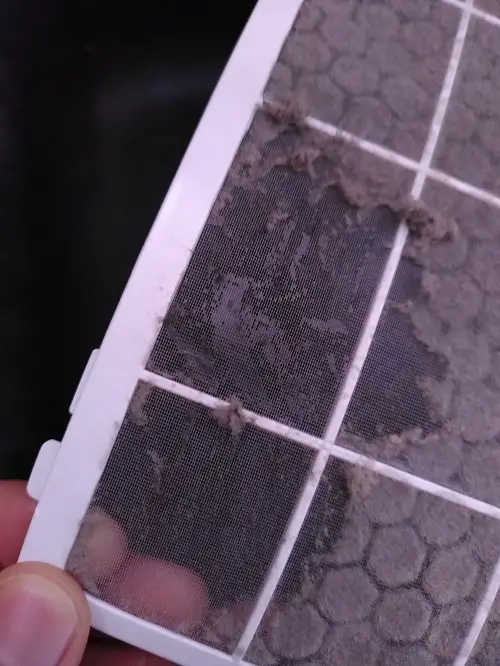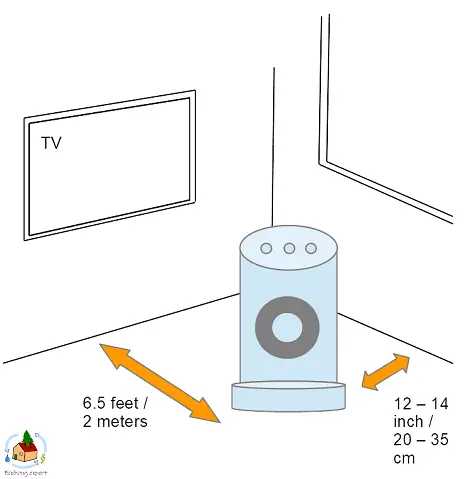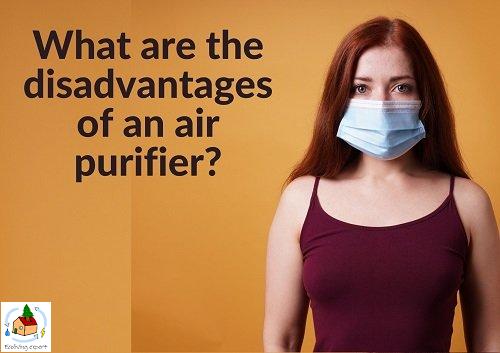Purchasing an air purifier is a good idea if you want to improve the quality of your indoor air. However, there are some disadvantages to using an air purifier. This article will help decide if an air purifier is the right tool for you.
There are three true disadvantages to running an air purifier. They require an initial investment plus running costs. Their fan creates airflow, which can feel cold, and they can make noise of up to 70 decibels.
On top of that, there are several requirements, effects, or issues that are disadvantageous to running an air purifier:
- You need to have the windows closed
- It creates airflow
- Regular maintenance is required
- Old filters worsen air quality
- An air purifier needs free space around it
- Air purifiers are not entirely quiet
- Some air purifiers produce ozone
- It does not solve all indoor air quality problems
- Many air purifiers do not remove odors
- Running costs
- Costs of filter replacement
- Initial purchase costs
- Its yet another electrical device running in your home
At the end of this article, I discuss why I recommend using an air quality monitor rather than an air purifier.
You need to have the windows closed while running the air purifier
In my opinion, this is one of the main disadvantages of an air purifier. Normally, if you want to improve the air quality in your house, you open a few windows and let in a cool breeze. Indoor air is normally about 3 to 5 times worse than outdoor air. Therefore, ventilation remains the number one thing you should do to improve indoor air quality.
Next to ventilation, an air purifier works wonders on your air quality. However, you cannot do both. An air purifier won’t improve your indoor air when the air is constantly being exchanged for new outdoor air.
I recommend starting with ventilating often and only using an air purifier at times when you don’t want to open any windows. An air purifier is excellent when, for example, outdoor noise or the weather does not allow for constant ventilation.

An air purifier creates airflow
Air purifiers work by running air through their filters by using a fan. Because of this, they create significant airflow around the device. That is, of course, necessary to get all your air filtered. However, I find the feeling of airflow a little uncomfortable and cold, like the room has a severe draft.
Additionally, airflow initially worsens air quality. Because the air moves more rapidly, most dust settled on surfaces becomes airborne again. Of course, the air purifier takes care of that quickly. However, it would be best to let the air purifier do its job for about an hour before entering the room.
An air purifier requires regular maintenance
Air purifiers come with a set of filters through which the air is pushed by a fan. The different types of filters take up dust, dander, pollen, microorganisms, and some gases, depending on the type of filter.
However, these filters tend to get saturated quickly and need to be cleaned or replaced often. The current best filters, HEPA filters, are excellent for airborne particle removal. However, they need to be replaced every 6 to 8 months.
What filter removes what type of pollutant? You can read all about the different types of filters in my article: True HEPA vs HEPA-type: application, durability, costs, and efficiency. Here, you will find a table showing what filters remove what type of pollutants.
Old air filters worsen air quality
When you have old, clogged filters, the air purifier cannot filter particles and gases from the air anymore. However, it does still run its fan and circulate the air through its filters. Hereby, it increases the air circulation in the room. This is actively bad for your indoor air quality.
Air circulation kicks up dust and other particles that have settled on surfaces. Normally, these particles are then filtered by the air purifier. With clogged filters, however, these particles will remain in the air and are a net negative on air quality compared to not running the air purifier.

An air purifier can be large and needs space
Some air purifiers are quite large and can be a thorn in the eye. Additionally, they take up quite some space and often require a designated spot for them to stand. They cannot simply be set in a corner but require sufficient space around them. Additionally, air purifiers need to be placed in a good spot in order to work most effectively.
Your air purifier needs to be 12 – 14 inches (30 – 35 cm) away from the walls and furniture. Additionally, there should be 6.5 feet (2 meters) of space between other electrical appliances. Furthermore, it requires a distance of 4 inches (10cm) from other objects.
You can read all about how to perfectly place your air purifier in my article: Where should air purifiers be placed? (ensure optimal performance)

Air purifiers are not entirely quiet
Although they do not make too much noise, air purifiers do make some sound, and you might want to conder how much you can tolerate. Especially when you want to use it for, for example, working at your home office.
A quiet air purifier normally produces about 30 to 40 decibels. This is about as much sound as a whisper to moderate rainfall. However, some air purifiers can create up to 70 decibels, which is equivalent to traffic noise and will definitely be a nuisance.
The noise and light coming from an air purifier can be a nuisance, especially during the night when you’re trying to sleep. If you want to know more about running an air purifier during the night, I recommend reading my article: Is it safe to sleep with the air purifier on? (+ where to place it)
An air purifier produces 30 to 40 decibels. Similar to a whisper or moderate rainfall.
Some air purifiers create ozone, which is a harmful gas
Some air purifiers, called ionizers, produce ozone. Other air purifiers sometimes have an ionization mode. This can aid in particle removal but the ozone itself is actively bad for your health. Ionized particles more easily stick to surfaces such as the air filter. However, it also sticks more easily to your lungs. Therefore, it should be avoided. Because of this, the US Environmental Protection Agency (EPA) does not recommend the use of ionizers.
However, the ionizers that are part of some air purifiers are thoroughly tested and comply with standards limiting ozone emittance. Additionally, some air purifiers come with the option of turning off the ionizer. In this way, you can for example only turn on the ionizer when you are not in close proximity to the air purifier. Often these ionizers emit such a low amount of ozone that they are safe according to US or EU legislation.
I recommend staying away from ionizers. If your air purifier does have an ionization option, make sure to only use it when no one is in the room.
An air purifier does not solve all indoor air quality problems
Air purifiers are great for removing particles from the air, making it significantly healthier to breathe. However, they do not solve all indoor air quality problems. Factors influencing indoor air quality that are not solved by an air purifier include:
- uncomfortable humidity levels
- odors
- uncommon air pollutants
If you want to know everything about indoor air quality, I highly recommend reading my article: The complete indoor air quality guide for your home.
Humidity levels are not affected by an air purifier
Humidity is an important factor in air quality. Along with the temperature, it is vital for your thermal comfort. Additionally, it affects other factors such as your health and your furniture. An air purifier, however, does not affect the humidity of your air in any way.
If you have uncomfortably high levels of humidity, a dehumidifier can greatly improve this aspect of air quality for you. I recommend reading my article about dehumidifiers and air quality. These devices also include a filter that removes airborne particles.
Sometimes, the air feels very dry when running your air purifier. In my article about air purifiers and dry air, you will find more information:
Many air purifiers do not remove odors
It might seem like odor removal is an easy task for an air purifier. However, many air purifiers are actually not removing bad smells from the air. Air purifiers are mostly designed to remove harmful airborne particles such as dust and pollen. For an air purifier to be able to remove odors, a special filter is required.
The best and most common filter for removing odors is an activated carbon filter. I recommend making sure when purchasing an air purifier that it has one. You can read all about odor removal in my article: Do air purifiers remove odor? (required filters and specifications).
Running costs
An air purifier generally uses around 100 watts. Meaning it uses 0.1 kilowatts of electricity per hour. One kilowatt of electricity generally costs around 14 cents (average US electricity price).
Therefore, running an air purifier for, let’s say, 12 hours a day, will cost about 17 cents, or about 5 dollars per month. Not much, but it might be something to consider.
Running an air purifier costs 5 dollars per month.
For more information about how long you should run your air purifier, I recommend reading my article:
The costs of filter replacement
The price of air purifier filters ranges between 5 and 50 dollars depending on the quality of the filter. A common low-standard filter is often available for 5 to 10 dollars while a high-standard HEPA filter can cost up to 50 dollars. The type of filter that you need depends on the purifier that you have and will be specified in the owner’s manual.
On top of that, the durability of the filter and the air quality in your home determines how often you will need to replace the filter. The yearly costs of filter replacement can therefore differ significantly.
The following table gives an indication of the costs of filter replacement. The pricing is based on common filters found on amazon.
| MERV rating | Price of pack ($) | Price for 1 ($) | Replacement period |
|---|---|---|---|
| 4 | 48 (for 6) | 8 | Once per year |
| 8 | 35 (for 6) | 6 | Every 2 to 3 months |
| 12 | 41 (for 6) | 7 | Every 1 to 3 months |
| 16 | 36 (for 1) | 36 | Once per year |
| 17+ (HEPA) | 49 (for 1) | 49 | Every 6 to 8 months |
The MERV rating is a rating system for the quality of air filters. the higher the number, the better the filter. Today, many air purifier manufacturers try to use HEPA filters as this is the current best filter on the market. However, it is often not necessary for households to use such expensive filters.
In my article True HEPA vs HEPA-type: application, durability, costs, and efficiency, you will find a table showing the differences between perfectly fine filters and the best filters on the market.
The initial cost of purchase
Although the running costs are very cheap, the initial purchase can be tough. Especially when you want to buy a good model. Some air purifiers will cost just under 100 dollars while others cost upwards of 600 dollars. The price depends on the size of the room you want to have cleaned, as well as the types of filters you require. Additionally, air purifiers can have all kinds of special features such as remote control with an app or specific modes such as an eco- or sleep mode.
Some air purifiers will costs just under 100 dollars while others cost upwards of 600 dollars.
Its yet another electrical device running in your home
This might not seem like such a big issue, but it is good to be aware of the fact that you will occupy another socket, have another machine running in your house and add to your electrical bill. Additionally, although an air purifier does not use that many watts, you will need to consider how many watts you can pull from one electrical group in your home. You do not want to overload the circuit.
Find out if you really need an air purifier
Before purchasing an air purifier, you should consider if you really need one. I wrote an article in which I take you along the steps of determining if you really need an air purifier. You can find it here: How to know if you need an air purifier (+ what it does and doesn’t do).
Why I recommend using an air quality monitor instead
Although an air purifier is a wonderful tool, ventilation is still your best weapon against indoor air pollution. Therefore, measuring the air with a good air quality monitor and ventilating when necessary is an excellent alternative to an air purifier. An air quality monitor has the advantage over an air purifier in that it tests for more compounds than an air purifier can remove. For example, an air quality monitor informs you about the presence of carbon monoxide and radon. An air purifier does not, and can’t remove these compounds from the air.
In looking for the best air quality monitors available, I found a Norwegian company called Airthings, which produces exceptional air quality monitors. They are easy to operate (just wave your hand in front of the device) and send their data to an app on your phone.
Get a 10% discount on Airthings air quality monitors
Readers of this website can get a 10% discount on Airthings devices using my coupon code. With the following coupon code, you can access the discount store: discount.airthings.com. Here, you will get access and 10% off when entering this coupon code: 665381-10OFF.



1 thought on “What are the disadvantages of an air purifier?”
Comments are closed.